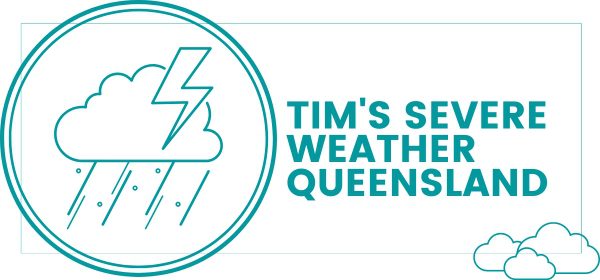Table of Contents
Did you know that Australia has experienced some of the most extreme weather phenomena in history? From devastating floods to deadly bushfires, severe weather events have shaped the country’s climate and landscape for centuries. Australia’s severe weather records tell tales of destruction and resilience, showcasing the impact that these events have had on the nation and its people.
Key Takeaways:
- Australia has a long history of severe weather events that have left a lasting impact on the country.
- Notable weather events in Australian history include floods, heatwaves, bushfires, cyclones, dust storms, and more.
- Climate change is contributing to the increase in severe weather events in Australia.
- Indigenous knowledge plays a crucial role in understanding and managing severe weather events.
- The aviation industry faces unique challenges during severe weather events.
Floods in Australia
Australia has a history of enduring devastating floods, brought about by heavy rainfall, leading to significant damage to property and infrastructure. These flood events serve as a stark reminder of the destructive power of nature, leaving a lasting impact on the affected regions.
One of the most notable historical floods in Australia is the 1893 Brisbane flood, which occurred in Queensland. The relentless downpour caused the Brisbane River to burst its banks, leading to extensive flooding throughout the city and surrounding areas. The catastrophic event resulted in the loss of many lives and significant damage to property.
Flood image – Floods in Australia
Flood Event |
Year |
Location |
|---|---|---|
1893 Brisbane flood |
1893 |
Brisbane, Queensland |
1971 Canberra flood |
1971 |
Canberra, Australian Capital Territory |
1974 Brisbane flood |
1974 |
Brisbane, Queensland |
March 2010 Queensland floods |
2010 |
Various regions in Queensland |
Another notable flood event occurred in 1971, when the Australian Capital Territory, particularly Canberra, experienced a disastrous flood. Heavy rainfall caused the Murrumbidgee River to overflow, leading to widespread flooding in the region. The flood resulted in the loss of lives and caused significant damage to infrastructure.
These historical floods in Australia demonstrate the immense power and destructive force of nature. They serve as a stark reminder of the importance of preparedness and appropriate infrastructure to mitigate the impact of severe rain-induced floods.
Furthermore, the 1974 Brisbane flood stands as one of the most devastating flood events in Australian history. Over several weeks, significant rainfall saturated the catchment area, causing the Brisbane River to break its banks and submerge vast sections of the city. The flood resulted in widespread damage to homes, businesses, and infrastructure, and tragically claimed the lives of more than a dozen people.
The March 2010 Queensland floods were another series of catastrophic flood events that affected many regions of Queensland. Exceptionally heavy rainfall resulted in widespread flooding across the state, causing extensive damage to homes, infrastructure, and agricultural land. The floods also brought significant economic impact, with recovery efforts taking years.
These major floods in Australian history underscore the importance of preparedness, response, and ongoing efforts to manage the impact of severe rain-induced floods on communities and infrastructure.
Heatwaves in Australia
Australia is no stranger to extreme heatwaves, which have severe impacts on both human health and the environment. These prolonged periods of high temperatures can lead to heat-related illnesses, such as heat stroke and dehydration, and place significant stress on ecosystems, agriculture, and infrastructure. Historical heatwaves in Australia serve as a stark reminder of the dangers and challenges posed by extreme heat events.
One of the most notable heatwaves occurred in Southeast Australia in 2009, resulting in record-breaking temperatures. Hopetoun, Victoria recorded a scorching high of 48.8 degrees Celsius, while Melbourne reached 46.4 degrees Celsius. This extreme heatwave had devastating consequences, triggering the infamous “Black Saturday” bushfires, which claimed many lives and destroyed thousands of homes. The combined impact of the heatwave and bushfires made it one of the deadliest natural disasters in Australian history.
Heatwaves continue to be a major concern in Australia, especially in the context of climate change. As global temperatures rise, heatwaves are becoming more frequent and intense. Rising greenhouse gas emissions and changes in weather patterns exacerbate the risk of extreme heat events, posing significant challenges to individuals, communities, and the nation as a whole.
Impact of Heatwaves in Australia
The impact of heatwaves in Australia is far-reaching, affecting various aspects of society and the environment:
“Heatwaves are silent killers that claim more lives each year than any other natural disaster in Australia, including bushfires and floods. They disproportionately affect vulnerable populations, such as the elderly, young children, and individuals with pre-existing health conditions.”
Furthermore, heatwaves can strain energy systems and contribute to power outages as demand for cooling increases. They also pose risks to agriculture, with heat stress causing reduced yields and livestock losses. Heatwave-associated drought can exacerbate water scarcity and impact water supply for both human consumption and agricultural activities.
Australian Heatwave Records
Australia holds several heatwave records that highlight the intensity of extreme heat events experienced in the country:
Record |
Location |
Year |
|---|---|---|
Highest recorded temperature |
Hopetoun, Victoria |
2009 |
Highest average temperature over a week |
Touraneena, Western Australia |
2003 |
Most consecutive days above 40 degrees Celsius |
Oodnadatta, South Australia |
1930-1931 |
These records provide a glimpse into the extreme nature of heatwaves in Australia and serve as reminders of the need to prioritize heatwave preparedness and climate resilience.
As heatwaves continue to pose a significant threat, it is crucial to implement strategies that address the impacts of extreme heat events. These strategies include heatwave early warning systems, urban planning that prioritizes heat mitigation, public awareness campaigns, and support for vulnerable populations.
By understanding the historical context, heatwave records, and the far-reaching impacts of heatwaves, Australia can develop effective strategies to mitigate the risks associated with extreme heat and build resilience in the face of a changing climate.
Bushfires in Australia
Australia is no stranger to bushfires, which have had a significant impact on the country throughout its history. From sprawling wildfires that consume vast areas of land to smaller, localized fires, bushfires are a natural part of Australia’s ecosystem. However, some historical bushfire events have stood out for their unprecedented scale and devastating consequences.
Historical Bushfires in Australia
One of the most notable bushfire seasons in recent memory is the 2019-2020 bushfire season. This season witnessed an unprecedented level of destruction, with fires ravaging 5.5 million hectares of land and destroying thousands of homes across the country. The impact of these fires was felt not only in terms of the immediate loss of life and property but also in their long-lasting effects on the environment and communities.
“The 2019-2020 bushfire season in Australia was a wake-up call for the nation. The scale and intensity of the fires highlighted the urgent need for effective bushfire management strategies and climate change mitigation measures.”
The 2019-2020 bushfire season also sparked international attention and brought the issue of climate change to the forefront. The severity of the fires and their connection to rising temperatures and drier conditions fueled discussions on the impact of climate change and the need for more proactive measures to prevent and combat bushfires.
Impact of Bushfires in Australia
The impact of bushfires in Australia extends beyond immediate destruction. These events have far-reaching consequences for ecosystems, wildlife, and the economy. The loss of vegetation due to bushfires can disrupt ecosystems and lead to soil erosion, affecting the habitat of many native species. The economic impact of bushfires is also significant, with industries such as agriculture and tourism being directly affected.
Bushfires also pose a threat to human lives and property. The risk of fatalities and injuries increases during severe fire seasons, and the destruction of homes and infrastructure can displace communities and cause widespread disruption.
Severe Fire Seasons in Australia
Australia has experienced several severe fire seasons throughout its history. These fire seasons are characterized by extreme weather conditions, including prolonged drought, high temperatures, and strong winds, which create ideal conditions for bushfires to start and spread rapidly.
Severe Fire Season |
Area Affected |
Key Events |
|---|---|---|
2019-2020 |
Nationwide |
– Unprecedented scale and intensity of fires – Loss of life and widespread destruction |
2009 |
Victoria |
– Black Saturday bushfires – Deadliest bushfire event in Australian history |
2003 |
New South Wales |
– Canberra bushfires – Loss of property and human lives |
These severe fire seasons serve as reminders of the need for ongoing research, preparedness, and proactive measures to mitigate the impact of bushfires in Australia.
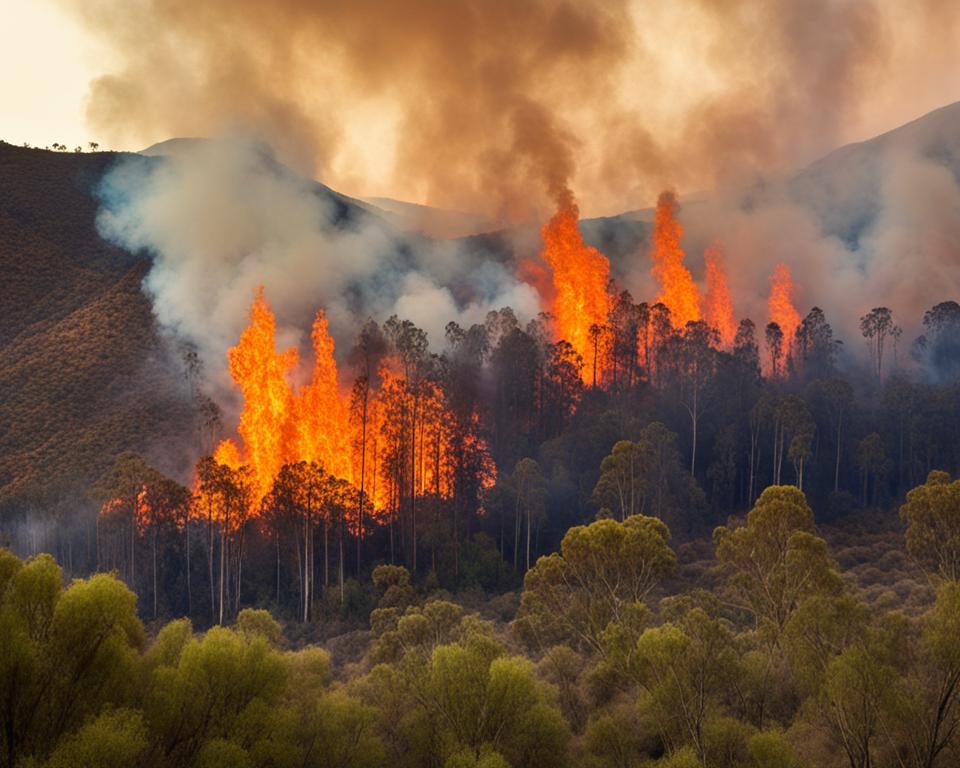
As Australia continues to face the challenges posed by bushfires, it is crucial to prioritize efforts in bushfire management, improve early warning systems, and invest in climate change adaptation strategies. By doing so, the country can better protect lives, ecosystems, and communities from the devastating effects of bushfires.
Cyclones in Australia
Australia’s northern region frequently experiences tropical cyclones, which can cause significant damage to coastal communities. These powerful weather systems are characterized by strong winds, heavy rainfall, and storm surges, making them a major threat to the region. One of the most notable cyclones in Australian history is Darwin’s Cyclone Tracy in 1974.
Cyclone Tracy:
“Cyclone Tracy was one of the deadliest cyclones to hit Australia. On Christmas Day in 1974, it struck the city of Darwin in the Northern Territory, causing widespread destruction and taking the lives of more than 70 people. With wind speeds reaching up to 240 km/h (150 mph), Cyclone Tracy devastated the city, leaving it in ruins.”
Tropical cyclones are classified based on their wind speeds using the Australian Tropical Cyclone Intensity Scale. The scale ranges from tropical disturbances (Category 1) to severe cyclones (Category 5). These classifications help to assess the potential impact of a cyclone and guide preparedness and response efforts.
The impact of cyclones in Australia goes beyond the immediate destruction caused by strong winds and heavy rain. Flooding, storm surges, and infrastructure damage can have long-lasting consequences for affected communities. It is crucial for residents in cyclone-prone areas to be prepared and have evacuation plans in place to ensure their safety.
Table: Notable Cyclones in Australian History
Tropical Cyclone Yasi |
2011 |
Category 5 |
Queensland |
|
Cyclone Larry |
2006 |
Category 4 |
Queensland |
|
Cyclone Debbie |
2017 |
Category 4 |
Queensland, New South Wales |
|
Tropical Cyclone Tracy |
1974 |
Category 4 |
Northern Territory |
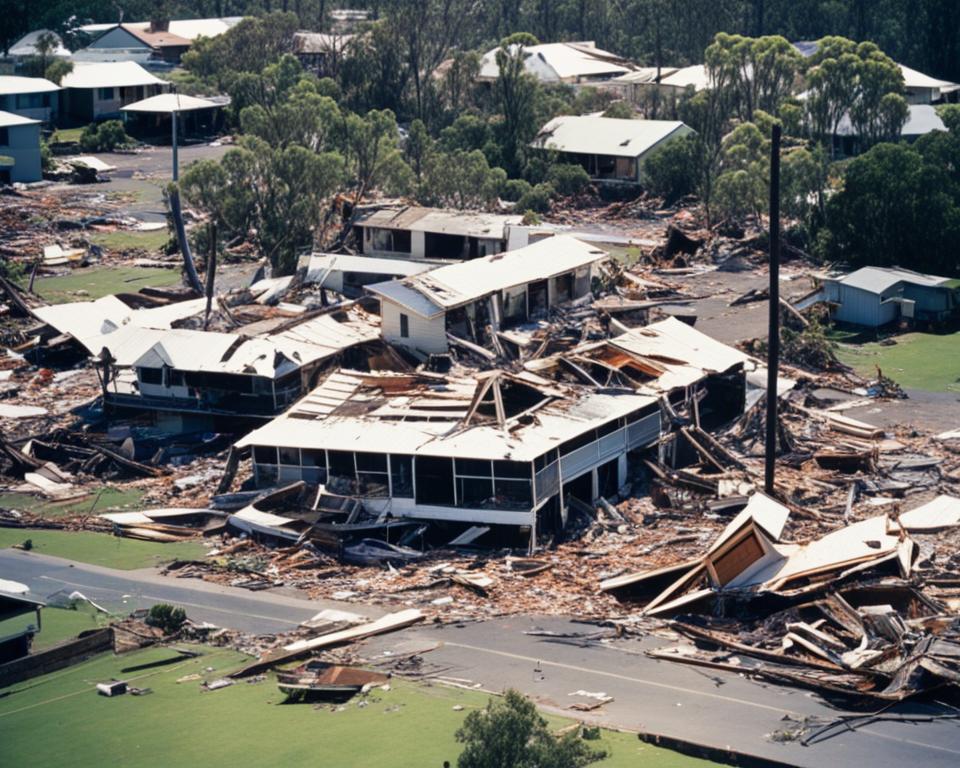
The impact of cyclones in Australia underscores the importance of preparedness, early warning systems, and effective emergency responses. By understanding historical cyclone events and their impact, communities can better mitigate risks, protect lives, and strengthen resilience in the face of future severe weather events.
Dust Storms in Australia
Australia has experienced its fair share of dust storms, which are extreme weather events that can create hazardous conditions and significantly impact visibility. Dust storms occur when strong winds lift large amounts of dust and sand particles from the ground and carry them through the air. These events are often associated with long periods of drought, which contribute to the severity of dust storms and amplify their impact on the environment and human health.
Throughout Australian history, there have been several major dust storms that have left a lasting impression. Two notable examples include the dust storms that occurred on February 3, 2005, and October 23, 2002. These events affected major cities like Melbourne and Sydney, causing widespread disruption and affecting daily life for residents.

During these dust storms, large amounts of dust particles were lifted into the atmosphere, reaching heights of up to 4.5 kilometers. The sky turned a reddish-brown color, and visibility was reduced to just a few meters in some areas. The impact of these dust storms was felt not only in terms of reduced visibility but also through the effects on air quality and respiratory health.
The severity of dust storms in Australia is influenced by a combination of factors, including drought, wind patterns, and the nature of the landscape. The dry and arid regions of the country are particularly susceptible, as loose soil and lack of vegetation make it easier for dust to be lifted and transported by strong winds.
In order to mitigate the impact of dust storms, it is important to monitor weather patterns and provide early warnings to the public. Dust storm preparedness measures can include issuing health advisories, implementing air quality monitoring systems, and encouraging individuals to take precautions such as staying indoors, wearing protective masks, and securing loose objects that can be blown away by strong winds.
Impact of Dust Storms
Dust storms have numerous impacts on various aspects of life in Australia. Some of the key areas affected by dust storms include:
- Health: Dust storms can worsen respiratory conditions and cause irritation in the eyes, nose, and throat. Fine particles suspended in the air can also have long-term health implications.
- Transportation: Dust storms can disrupt air and road transportation, leading to delays and cancellations. Reduced visibility and hazardous driving conditions make it unsafe to travel during these events.
- Agriculture: Dust storms can have adverse effects on agricultural activities, damaging crops, depleting soil nutrients, and affecting livestock health. Dust deposition on plants can limit their ability to photosynthesize effectively.
- Environment: Dust storms can transport significant amounts of soil particles over long distances, leading to soil erosion and degradation. It can also impact biodiversity by covering vegetation, altering ecosystems, and affecting the habitats of various species.
To better understand the impact of dust storms and develop strategies for mitigation and adaptation, ongoing research and monitoring efforts are essential. By studying the causes and patterns of dust storms, scientists and policymakers can work towards minimizing the risks associated with these severe weather events and protecting the well-being of all Australians.
Floods vs. Dams in Australia
When it comes to severe weather events in Australia, floods and dam failures are two distinct phenomena that can have significant consequences. While floods primarily occur due to heavy rainfall, dam failures can also lead to devastating floods. Understanding the differences between these events is crucial for effective flood management and ensuring the safety of communities living in flood-prone areas.
Let’s take a closer look at the impact of floods on dams and the measures in place to manage and mitigate their effects:
The Impact of Floods on Dams
Floods can exert immense pressure on dam infrastructure, putting them at risk of failure. When floodwaters exceed a dam’s design capacity, the structural integrity of the dam can be compromised, leading to breaches or even complete collapses. The force of the rushing water can erode the foundation of the dam, weaken its structure, and potentially release massive volumes of water downstream, causing widespread flooding and endangering lives and property.
Flood Management in Australia
Australia, being prone to floods, has implemented various flood management strategies to enhance preparedness, early warning systems, and response mechanisms. These include:
- Monitoring and prediction systems: Australia has invested in advanced monitoring and predictive technologies to closely track rainfall patterns and river levels. This enables authorities to issue timely flood warnings and advisories to vulnerable communities.
- Emergency response plans: Local and state governments have developed comprehensive emergency response plans to coordinate rescue and relief efforts during flooding events. These plans involve the deployment of emergency services, evacuation procedures, and the establishment of temporary shelters for affected individuals and families.
- Floodplain zoning and building regulations: Authorities have implemented strict regulations on land use and construction activities in flood-prone areas. Floodplain zoning maps and building codes help reduce the risk of infrastructure damage and safeguard lives and property.
Dam Infrastructure in Flood-Prone Areas
Constructing dams in flood-prone areas requires careful planning, engineering expertise, and ongoing maintenance to ensure their safety and efficacy. Several factors are considered when designing dam infrastructure in flood-prone areas, including:
- Hydraulic modeling: Engineers use advanced hydraulic modeling techniques to simulate potential flood scenarios and assess their impact on dams. This helps optimize dam designs and ensure they can cope with extreme flood events.
- Flood storage capacity: Dams built in flood-prone areas are designed with sufficient storage capacity to accommodate excess floodwaters without compromising their structural integrity. This helps regulate downstream water levels and reduce the risk of flooding.
- Safety measures and maintenance: Regular inspections, maintenance, and upgrades are essential to keep dam infrastructure resilient against flooding. This includes monitoring and reinforcing the dam’s embankments, spillways, and outlet works to withstand the forces exerted during flood events.
“Proper flood management and robust dam infrastructure are critical for minimizing the impact of both natural and man-made flood events. By understanding the differences between floods caused by rainfall and those resulting from dam failures, we can develop strategies that safeguard our communities and protect our vital infrastructure.”
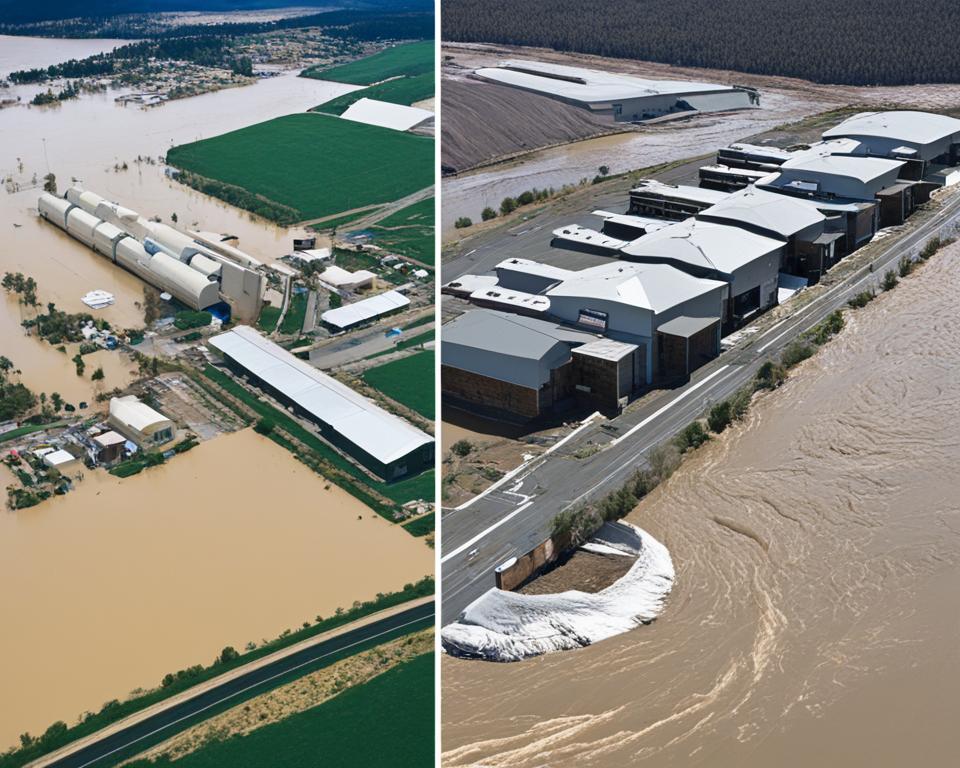
Impacts of Climate Change on Severe Weather Events
Climate change is having a profound impact on severe weather events, not just globally but also in Australia. Scientists widely agree that rising temperatures and warmer oceans are key factors contributing to the increase in extreme weather phenomena.
One of the major consequences of climate change is the intensification of rainfall. As the atmosphere warms, it holds more moisture, resulting in heavier and more frequent downpours. This has led to an increased risk of flooding in many regions, including Australia.
Extreme rainfall events have become more pronounced, with intense storms causing flash floods that overwhelm drainage systems and put communities at risk. This trend is expected to continue as the effects of climate change become more pronounced.
Not only is climate change increasing the intensity of rainfall events, but it is also exacerbating the occurrence and severity of heatwaves. Rising temperatures and prolonged periods of hot weather are becoming more frequent, leading to higher risks of heat-related illnesses and even death.
Australia has already experienced a number of devastating heatwaves, such as the historic event in 2009 that saw record-breaking temperatures across Southeast Australia. Heatwaves pose numerous challenges, including increased demand for energy and strain on infrastructure.
Furthermore, climate change is prolonging droughts, making them more severe and widespread. Higher temperatures and changing rainfall patterns can lead to reduced water availability and agricultural productivity, affecting communities and ecosystems reliant on water resources.
The link between climate change and severe weather events
While individual weather events cannot be directly attributed to climate change, there is a clear and scientifically documented link between the two. The increasing occurrence and severity of extreme weather events align with the predictions of climate models and the underlying mechanisms of climate change.
As greenhouse gas emissions continue to rise, the impacts of climate change on severe weather events are expected to worsen. It is crucial to understand these connections to inform strategies for resilience and adaptation to future severe weather events.
Examples of Climate Change Impacts on Severe Weather Events
Severe Weather Event |
Climate Change Impact |
|---|---|
Flooding |
Increased intensity and frequency of rainfall events leading to higher flood risks. |
Heatwaves |
Rising temperatures and prolonged hot weather resulting in more frequent and severe heatwaves. |
Droughts |
Changing rainfall patterns and higher temperatures leading to more prolonged and severe droughts. |
Understanding the impacts of climate change on severe weather events is essential for developing effective strategies to mitigate risks and protect communities. By taking proactive measures and adapting to the changing climate, we can better prepare for the challenges that lie ahead.
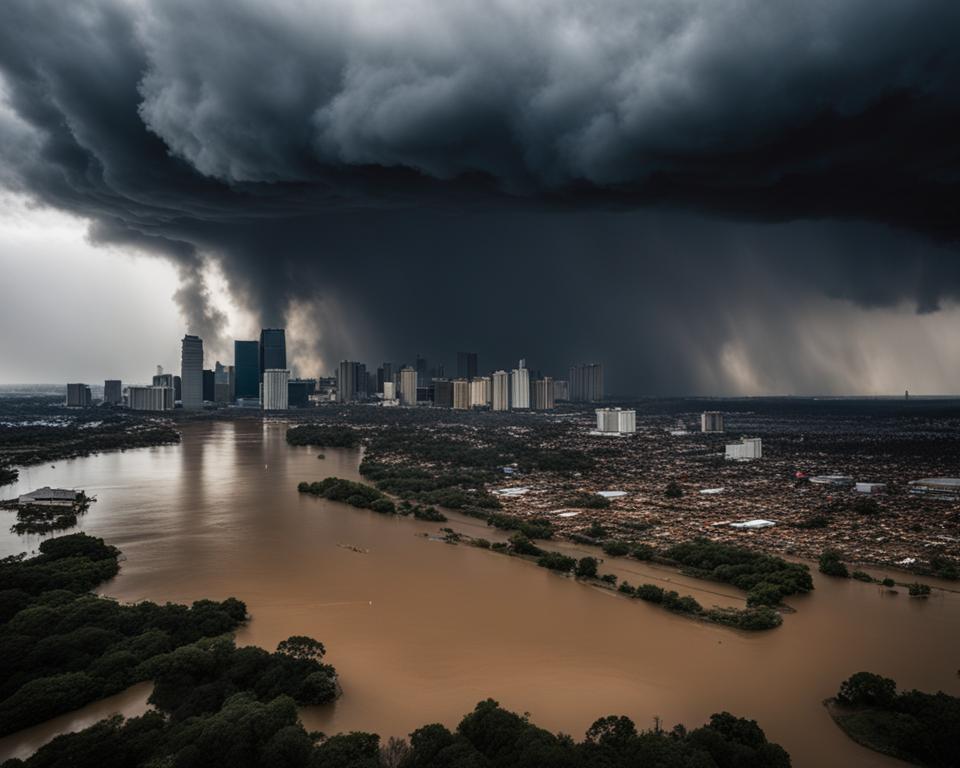
Indigenous Knowledge and Severe Weather Events
Indigenous cultures in Australia have maintained a deep understanding of severe weather events that has been passed down through generations. Their traditional knowledge and weather forecasting techniques provide valuable insights into the complexities of Australian weather patterns.
Indigenous knowledge of severe weather events encompasses a holistic understanding of natural indicators, such as cloud formations, wind patterns, animal behavior, and celestial movements. By closely observing and interpreting these signs, Indigenous communities have been able to predict and prepare for extreme weather conditions.
One example of traditional weather forecasting in Australia is the use of the “seasonal calendar,” which divides the year into different weather phases based on the behavior of flora and fauna. This calendar serves as a guide for agricultural activities and informs communities about the expected weather patterns during each season.
Indigenous perspectives on Australian weather go beyond scientific observations; they are deeply intertwined with cultural, spiritual, and ecological connections to the land. The Aboriginal understanding of extreme weather is grounded in a deep respect for the environment and a recognition of the interconnectedness between humans and nature.
“Our ancestors taught us to read the signs of the land, the skies, and the animals. We know when a storm is coming, when it will rain, or when the winds will change direction. This knowledge helps us stay safe and prepared.”
Integrating Indigenous knowledge with modern scientific methods can enhance our understanding of severe weather events in Australia. Collaborative research projects and partnerships between Indigenous communities and meteorological agencies are fostering a more comprehensive and culturally sensitive approach to weather forecasting and management.
Indigenous Weather Forecasting Techniques
Indigenous weather forecasting techniques rely on a combination of empirical knowledge and spiritual connections to the environment. Here are some examples:
- Bush medicine plants: Observing the growth patterns and flowering times of specific plants to predict weather changes.
- Animal behavior: Monitoring the behavior of animals, such as birds, insects, and reptiles, as they often exhibit distinct signs signaling upcoming weather shifts.
- Fire and smoke: Analyzing the behavior of smoke and the scent in the air to anticipate changes in wind direction.
- Star constellations: Interpreting the movements of celestial bodies to foresee long-term weather patterns.
By acknowledging and respecting Indigenous perspectives on Australian weather, we can gain a deeper appreciation for the intricate relationships between people, land, and climate. Incorporating Indigenous knowledge into weather forecasting models can enhance our ability to predict and respond to severe weather events, ultimately improving the resilience of Australian communities.
Benefits of Integrating Indigenous Knowledge |
Challenges |
|---|---|
|
|
Aviation Challenges During Severe Weather Events
Severe weather events present significant challenges for the aviation industry in Australia. The impact of heavy rain, strong winds, and extreme heat on flight operations can result in delays or cancellations, disrupting travel plans for passengers. Additionally, flooding and reduced visibility pose serious safety concerns, making it impossible for aircraft to take off or land safely.
To ensure the safety of passengers and crew during severe weather conditions, aviation authorities implement stringent safety precautions. This includes closely monitoring weather conditions and issuing timely updates to flight operators. The decision to delay or divert flights is made based on the severity of the weather and the ability to ensure safe operations.
“Safety is our top priority in aviation. We closely monitor weather conditions and take necessary precautions to ensure the well-being of passengers and crew during severe weather events. This may include delaying or diverting flights to ensure the safety of all onboard.”
Weather monitoring technologies and advanced forecasting systems play a crucial role in mitigating the impact of severe weather on aviation. By providing accurate and timely information, pilots and air traffic controllers can make informed decisions to minimize disruptions and ensure safe travel.
During extreme weather conditions, aviation authorities also collaborate with other stakeholders such as airport authorities, ground crews, and maintenance teams to coordinate operations effectively. This ensures a holistic approach to safety and reduces the risk of accidents or incidents.
Table:
Aviation Challenges |
Impact |
Safety Precautions |
|---|---|---|
Heavy rain |
Reduced visibility, increased risk of hydroplaning |
Closely monitoring weather conditions, adjusting flight schedules accordingly |
Strong winds |
Turbulence, difficulty in aircraft control |
Implementing wind restrictions, diverting flights if necessary |
Extreme heat |
Overheating of aircraft systems, reduced lift |
Conducting thorough pre-flight inspections, modifying take-off and landing procedures |
Flooding |
Unsafe runway conditions, limited access to airports |
Closing affected runways, diverting flights to alternate airports |
Poor visibility |
Limited visual references, increased risk of collision |
Implementing instrument landing systems, conducting instrument approach procedures |
Rising Seas and Airports in Australia
Rising seas, a result of climate change, pose a significant threat to coastal airports in Australia. With the ongoing rise in sea levels, many airports located in low-lying areas, such as Cairns, Sydney, Brisbane, Townsville, and Hobart, are vulnerable to the impacts of sea-level rise. This vulnerability highlights the need to assess and address the long-term effects on airport infrastructure and develop effective adaptation strategies to ensure the continued operation of these critical transportation hubs.
The potential consequences of rising seas on coastal airports are multifaceted. First and foremost, the increased risk of frequent and intense storm surges threatens the structural integrity of airport facilities, including runways, terminals, and navigation systems. Storm surges caused by extreme weather events can lead to coastal flooding, erosion, and damage to essential infrastructure, disrupting airport operations and compromising safety.
Additionally, the encroaching rise in sea levels may result in the gradual inundation of low-lying airport areas, leading to permanent flooding and rendering runways unusable. This scenario presents logistical challenges, as airports must make critical decisions regarding relocations or costly modifications to existing infrastructure to adapt to the changing environment.
The vulnerability of coastal airports to sea-level rise emphasizes the importance of proactive planning and informed decision-making. It is crucial for airport authorities, policymakers, and stakeholders to implement robust adaptation measures that consider the predicted rate of sea-level rise and the unique characteristics of each airport’s location.
Potential adaptation strategies may include:
- Construction of protective barriers and levees to mitigate the impacts of storm surges and tidal flooding.
- Elevating critical infrastructure, such as runways and terminals, to ensure they remain above projected sea levels.
- Implementing coastal ecosystem conservation efforts, such as mangrove restoration, to provide natural barriers against erosion and storm surges.
- Collaborating with climate scientists and engineers to conduct regular assessments of vulnerability and formulate adaptive strategies.
These adaptation efforts must be guided by a holistic approach that incorporates the expertise of various stakeholders, including government agencies, local communities, and environmental organizations. By embracing climate-resilient practices, Australia’s coastal airports can better withstand the challenges posed by rising seas and continue to serve as vital gateways to the world.
Wet Season Challenges in Northern Australia
The wet season in Northern Australia, which extends from October to April, poses unique challenges for aviation. With high humidity and unstable atmospheric conditions, flying during this period can be hazardous. The presence of tropical cyclones and active monsoon troughs further complicates air travel, leading to heavy rainfall, squally winds, and thunderstorms.
Weather forecasters and pilots play a crucial role in ensuring the safety and reliability of flights during the wet season. They must closely monitor weather patterns and make informed decisions regarding flight paths and schedules to avoid the hazards associated with this time of year. The unpredictable nature of tropical cyclones and thunderstorms requires constant vigilance and adaptability.
During the wet season, thunderstorms can develop rapidly, posing a significant threat to aircraft operations. These storms are often accompanied by strong winds, turbulence, and reduced visibility, making take-offs and landings challenging. Pilots must possess the necessary skills and training to navigate through these adverse weather conditions safely.
Tropical cyclones, a common occurrence during the wet season, present additional risks to aviation. These powerful storms can bring destructive winds and torrential rains, creating dangerous flying conditions. Flight operations may be disrupted, and airports could be temporarily closed to ensure the safety of passengers and crew.
To mitigate the hazards of flying in the wet season, airlines and aviation authorities closely collaborate with meteorological agencies to receive up-to-date weather information. By utilizing advanced weather radar systems, satellite imagery, and meteorological models, aviation professionals can make informed decisions and take necessary precautions to ensure the well-being of passengers.
Tropical Cyclone Tracy and Aviation
“Tropical Cyclone Tracy, one of the most devastating cyclones in Australia’s history, made landfall on Christmas Day in 1974. The destructive winds and storm surge resulted in widespread damage and loss of life in Darwin. This tragic event highlighted the immense challenges cyclones pose to aviation in Northern Australia.”
Given the unique weather patterns and severe conditions experienced during the wet season, it is essential for pilots and airlines to prioritize safety and follow established protocols. Effective communication, continuous monitoring of weather conditions, and adherence to standard operating procedures are crucial to overcoming the wet season challenges in Northern Australia.
Fog and Aviation in Australia
While not as extreme as other severe weather events, fog can disrupt aviation operations in Australia. Foggy conditions can reduce visibility and pose challenges for take-offs and landings at airports throughout the country.
Fog is most prevalent in tropical regions near the coast during the dry season. Airports in areas such as Broome, Port Hedland, and Rockhampton experience foggy conditions multiple times a year, impacting flight schedules and causing delays.
When foggy conditions occur, airlines and airport authorities must take appropriate measures to ensure the safety and efficiency of flight operations. Special monitoring systems and mitigation strategies are necessary to minimize flight disruptions caused by fog. Proper communication and collaboration between pilots, air traffic controllers, and ground staff are essential to manage the impact of fog on aviation.
To illustrate the prevalence of fog in Australian regions, the table below showcases a few airports and the average number of foggy days they experience each year:
Airport |
Location |
Average Number of Foggy Days |
|---|---|---|
Broome International Airport |
Broome, Western Australia |
23 |
Port Hedland International Airport |
Port Hedland, Western Australia |
17 |
Rockhampton Airport |
Rockhampton, Queensland |
14 |
Minimizing the impact of fog on aviation requires continuous monitoring of weather conditions, advanced technology, and effective communication between all stakeholders. By understanding the prevalence and impact of fog, the aviation industry can ensure the safety and reliability of air travel in Australia.
Storm Surges and Coastal Airports in Australia
Storm surges, caused by wind action and low pressure on the ocean’s surface, can pose significant risks to coastal airports in Australia. These surges raise sea levels and produce large waves, potentially impacting airport infrastructure and operations.
The vulnerability of coastal airports to storm surges is further amplified by the effects of climate change. As rising sea levels and more frequent extreme weather events are driven by climate change, the risk of storm surge impacts on airports becomes even more pronounced.
Coastal airports in Australia, such as Cairns, Sydney, Brisbane, Townsville, and Hobart, are located in low-lying areas that are particularly susceptible to the effects of storm surges. The infrastructure and facilities at these airports, including runways, taxiways, and terminals, can be compromised by storm surge-induced flooding and wave action.
In addition to the direct physical damage to airport infrastructure, storm surge impacts can also disrupt airport operations. High waves and flooding can render runways and taxiways unusable, leading to flight delays, cancellations, and potential safety hazards for aircraft and passengers.
It is crucial for airport authorities and relevant stakeholders to assess the vulnerability of coastal airports to storm surges and develop strategies to mitigate the associated risks. This includes implementing coastal protection measures, such as seawalls or breakwaters, to minimize the impact of storm surges on airport infrastructure.
Furthermore, ongoing monitoring of sea levels, weather patterns, and storm surge forecasts is essential for early detection and preparedness. By staying vigilant and proactive, airport authorities can ensure the safety and resilience of coastal airports in the face of increasing storm surge risks.
Example Table: Vulnerability of Coastal Airports to Storm Surges
Airport |
Location |
Risk Level |
|---|---|---|
Cairns Airport |
Cairns, Queensland |
High |
Sydney Airport |
Sydney, New South Wales |
Medium |
Brisbane Airport |
Brisbane, Queensland |
High |
Townsville Airport |
Townsville, Queensland |
High |
Hobart Airport |
Hobart, Tasmania |
Medium |
Note: The risk level categorization is based on the vulnerability of each airport to storm surge impacts, taking into account factors such as location, elevation, and existing coastal protection measures.
Conclusion
Australia’s history is marked by a series of severe weather events that have shaped the country and its people. From devastating floods and bushfires to powerful cyclones and scorching heatwaves, these events have had significant impacts on the landscape and the lives of Australians.
Looking back at the historical severe weather events in Australia, we can draw valuable lessons and insights. These events have taught us the importance of preparedness, resilience, and adaptation in the face of extreme weather. They have highlighted the need for effective strategies and infrastructure to minimize risks and protect lives and property.
As we move forward, it is crucial to use the knowledge gained from Australia’s weather history to inform future planning and decision-making. Understanding the patterns and impacts of severe weather events can help us develop strategies for mitigating the risks associated with climate change. By working together, we can build a more resilient and sustainable future for all Australians.
FAQ
What are some notable historical floods in Australia?
Some notable historical floods in Australia include the 1893 Brisbane flood, 1971 Canberra flood, 1974 Brisbane flood, and the March 2010 Queensland floods.
What are the impacts of heatwaves in Australia?
Heatwaves in Australia have severe impacts on both human health and the environment. They can lead to record-breaking temperatures and contribute to the occurrence of devastating bushfires.
What are some major bushfire events in Australia?
One of the most significant bushfire events in recent history is the 2019-2020 bushfire season, which burned 5.5 million hectares of land and destroyed thousands of homes.
What are some notable cyclone events in Australian history?
Darwin’s Cyclone Tracy in 1974 is one of the most infamous cyclones in Australian history. It devastated the city and resulted in the loss of many lives.
When did major dust storms occur in Australia?
Major dust storms occurred on February 3, 2005, and October 23, 2002, in cities like Melbourne and Sydney.
What is the difference between floods caused by rainfall and those caused by dam failures in Australia?
Floods caused by rainfall are more common in Australia and are managed and mitigated through measures in place. However, dam failures can lead to devastating floods and highlight the importance of proper dam infrastructure and maintenance.
How does climate change impact severe weather events in Australia?
Climate change is contributing to the increase in severe weather events globally, including in Australia. Rising temperatures and warmer oceans lead to more intense rainfall, increased risk of flooding, exacerbation of heatwaves, and prolonged droughts.
How does indigenous knowledge contribute to understanding severe weather events in Australia?
Indigenous cultures in Australia have rich knowledge and understanding of severe weather events. Traditional weather forecasting techniques, passed down through generations, help communities prepare for and respond to extreme weather.
What are the challenges faced by the aviation industry during severe weather events in Australia?
Severe weather events, such as heavy rain, strong winds, extreme heat, and poor visibility, can affect flight operations, leading to delays or cancellations. Aviation authorities take precautions to ensure the safety of passengers and crew during these events.
How do rising seas pose a threat to coastal airports in Australia?
Rising seas, a result of climate change, pose a threat to coastal airports in Australia. Airports located in low-lying areas, such as Cairns, Sydney, Brisbane, Townsville, and Hobart, are vulnerable to sea-level rise.
What are the challenges faced by aviation during the wet season in Northern Australia?
The wet season in Northern Australia presents challenges for aviation due to high humidity, unstable atmospheric conditions, and the presence of tropical cyclones and active monsoon troughs, which can lead to heavy rainfall, squally winds, and thunderstorms.
How does fog disrupt aviation operations in Australia?
Fog can disrupt aviation operations in Australia by reducing visibility and affecting take-offs and landings. Airports in regions such as Broome, Port Hedland, and Rockhampton experience foggy conditions multiple times a year.
What risks do storm surges pose to coastal airports in Australia?
Storm surges, caused by wind action and low pressure on the ocean’s surface, can raise sea levels and produce large waves, potentially impacting airport infrastructure and operations. It is essential to assess the vulnerability of coastal airports and develop strategies to mitigate storm surge risks.
Source Links
- https://en.wikipedia.org/wiki/Category:Weather_events_in_Australia
- https://www.nla.gov.au/research-guides/weather-climate/extreme-weather-events
- https://www.caaa.com.au/7-of-the-most-extreme-weather-events-in-australia/
